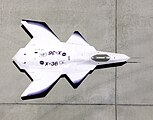Tập tin:McDonnell Douglas X-36 planform.jpg
Giao diện

Kích thước hình xem trước: 783×600 điểm ảnh. Độ phân giải khác: 313×240 điểm ảnh | 627×480 điểm ảnh | 1.003×768 điểm ảnh | 1.280×980 điểm ảnh | 2.560×1.961 điểm ảnh | 3.060×2.344 điểm ảnh.
Tập tin gốc (3.060×2.344 điểm ảnh, kích thước tập tin: 1,77 MB, kiểu MIME: image/jpeg)
Lịch sử tập tin
Nhấn vào ngày/giờ để xem nội dung tập tin tại thời điểm đó.
| Ngày/giờ | Hình xem trước | Kích cỡ | Thành viên | Miêu tả | |
|---|---|---|---|---|---|
| hiện tại | 21:00, ngày 23 tháng 6 năm 2011 |  | 3.060×2.344 (1,77 MB) | Liandrei | {{Information |Description ={{en|1=Planform of the McDonnell Douglas X-36 tailless prototype jet, designed to fly without the traditional tail surfaces used on most aircraft.}} | |
Trang sử dụng tập tin
Có 1 trang tại Wikipedia tiếng Việt có liên kết đến tập tin (không hiển thị trang ở các dự án khác):
Sử dụng tập tin toàn cục
Những wiki sau đang sử dụng tập tin này:
- Trang sử dụng tại cs.wikipedia.org
- Trang sử dụng tại en.wikipedia.org
- Trang sử dụng tại es.wikipedia.org
- Trang sử dụng tại lt.wikipedia.org
- Trang sử dụng tại sl.wikipedia.org
- Trang sử dụng tại uk.wikipedia.org



